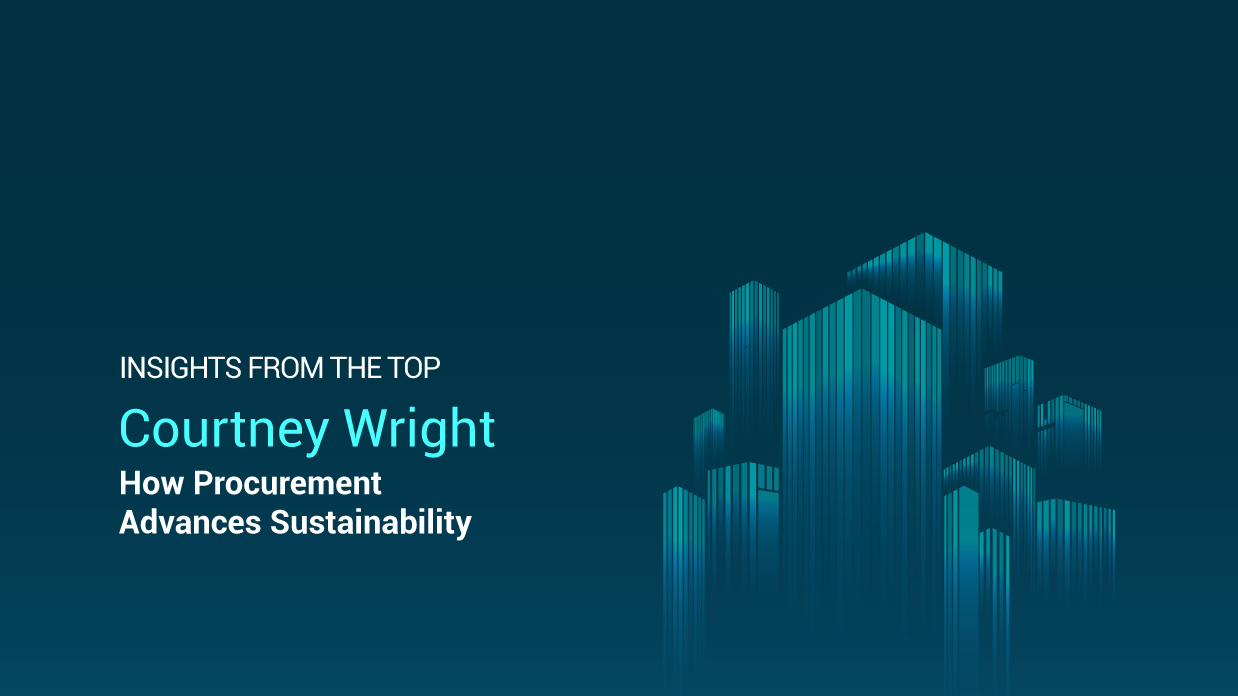How Procurement Advances Sustainability
Veolia is the global benchmark company for ecological transformation. Operating on five continents with nearly 220,000 employees, the group designs and deploys practical solutions for water, waste and energy management that contribute to a radical turnaround of the current situation. Veolia recently merged with SUEZ group, the French-based environmental services leader, doubling its size. To learn more about how procurement is supporting Veolia’s mission, GEP sat down with Courtney Wright, chief procurement officer of Veolia North America (VNA), named the largest U.S. environmental services company by Engineering News Record.

Q. What does Veolia do?
We may be one of the largest companies in the world that people haven’t heard of in North America. Veolia is a world leader in delivering environmental services, helping organizations reduce their environmental footprint in three core areas: water, waste, and energy. We help companies manage, source and switch to cleaner energy; municipalities and cities with their public drinking water and wastewater treatment plants; and enable companies to manage and dispose of waste properly, especially hazardous waste so it’s not causing long-term environmental harm.
Q. Describe your team and mission.
Our mission is to provide efficient, easy-to-use procurement solutions that help the business maximize the value derived from every dollar spent on goods and services. We manage all facets of the source-to-pay process, encompassing sourcing, contracting, purchasing, risk management and everything in between for our North American business. Our core team is about two dozen talented professionals who support more than 2,000 purchasers across the company.
I’m an engineer by training and have spent most of my career in chemical plants and field operations. It’s been a great opportunity for me to switch to corporate procurement and apply those skills in a new way, especially in support of Veolia’s customers, who are working to mitigate the environmental impact of their activities.
Q. What are your big categories of purchases?
Beyond energy and utilities, chemicals are a significant category, followed by transportation. Because we provide service to customers at hundreds of different locations, transportation, logistics and fleet are essential.
Q. How do you track procurement’s contribution?
Financial metrics are, and will remain, key. Demonstrating savings is a principal reason why our team exists. However, a focus for us over the last couple of years has been to move beyond being viewed simply as a purchasing organization and savings generator, by showing the value of procurement as a strategic partner helping the business succeed.
We’ve spent a lot more time educating colleagues around the non-financial side of our value, including risk management and supply chain continuity, especially during COVID. Moving beyond COVID, we’re increasingly playing a vital role in risk management related to cybersecurity, data privacy and security with our IT and legal teams.
Veolia has a large diversity, equity and inclusion program both internally and externally, so increasing supplier diversity and creating a more inclusive supplier network to reflect the communities in which we serve are another important non-financial way we contribute. We also help our business development teams partner with our suppliers to create and land new sales opportunities.
Having had some solid success with projects, even small ones that go beyond the boundaries of traditional purchasing, have helped change the perception of our team and what we can do. We’re not just the team who helps buy stuff, and when we’re engaged earlier in the business processes, we’ve proven that we can provide more strategic support.
Q. How are you managing risk?
Our primary vehicle is to make certain we have the key provisions in our contracts to protect against all the various risks, whether something as basic as insurance and liability or more nuanced and complicated like personal identifiable information (PII) and data privacy. We use standardized contract templates to simplify the process and keep us organized. Procurement is the liaison between all the other business functions. We find out what each department is trying to protect and incorporate those elements into our source-to-contract process. In a way, we’re the glue to combine all those different pieces into a cohesive contract document. We also try not to make contracts overly one sided. While we always protect ourselves, we’re also mindful our supplier has the same kinds of needs. By finding a fair and equitable balance, we aim to build real partnerships with our suppliers.
Q. What are your ESG goals?
Our goal is not only to reduce our CO2 emissions to be net zero but to support our customers’ efforts to do the same. We’re trying to do things differently, do things better to reduce our impact, not just offset it, by reducing or eliminating some of the sources of carbon emissions. For instance, we’re engaging electricity providers to source green energy. We’re looking to purchase and, in some cases, produce renewable energy, and not just buy the least expensive option. It’s no longer just what we buy. How the goods and services are made is starting to play a central role in our sustainable purchasing strategy.
Q. How do you track suppliers’ impact on the environment?
Just as everybody is trying to do right now, we want to better understand our suppliers’ CO2 footprints. The key to success is to collect environmental data from suppliers in as easy a way as possible, so that we can then take action. We use questionnaires and digital tools to get the right information from suppliers about their impact on the environment, on their improvement plan, and where they are in their journey. Because it’s a journey for all of us. Not everybody’s in the same place. It’s about ensuring and supporting suppliers’ continuous improvement. We’re also investing in technology to help make suppliers’ data more visible. We want to go deeper than the summary performance data, we want to work with our suppliers to understand their action plans around sustainability and other risk factors.
Q. How are you mitigating rising costs?
The key to success is working closely with our suppliers. We’re not able to offset everything. That’s just the reality of the current environment. We work to balance suppliers’ needs with our own to keep costs down. Understanding each supplier’s situation helps us understand what costs can and can’t be mitigated. Moreover, if we do have to pass on price increases to our customers, understanding the why, the source of that increase, and what’s going on in that market helps us inform our stakeholders.
It’s all about effective partnership and communication. The past several years have dramatically increased the need for communication. My team has spent a lot more time not only talking to suppliers but also with our internal stakeholders. There’s a lot more interest among our business leaders about what’s going on in the marketplace. For instance, before COVID our business ordered chemicals, and other than a missed delivery date here and there, it was uneventful. Today, our business partners want to know the market intelligence on specific chemicals, where things are trending, and when inflation will decrease.
Our business partners are looking for an entire set of information from us, and candidly we were not really prepared for those questions at first. While our team was collecting the information for our own uses, we weren’t prepared to package it up and share it with our internal stakeholders. It’s been a good lesson for us to proactively communicate, try to anticipate the questions from across our business, and be prepared in case of an incident or a supplier has a shutdown or some kind of emergency.
Communicating early and often to our stakeholders about what’s happening and is likely to happen goes a long way toward keeping everyone focused, reducing risk and being better able to manage projects. Knowing is half the battle. And while it’s taken a lot of time and resources, anticipating issues and proactively communicating have been a good learning for us, and one which we plan to continue even after the economy calms down.
Q. Are you seeing price increases abate?
It really depends on the purchasing category. We have categories still experiencing increases, others that have started to turn, and for the first time in 16 months, we’re seeing some price decreases, which has been a very nice change of pace. Overall, it seems like many categories are beginning to stabilize. While prices aren’t necessarily coming down, we’re not seeing escalating prices in the same way as we experienced last year.
Q. How is technology enabling procurement?
We’ve just gone through a significant digital transformation, updating our ERP platform and purchasing system. We started at the beginning of last year, and completed the rollout this year. It’s really satisfying to move past the implementation phase, get everything stabilized and start to optimize our systems and tools to their fullest capability.
Some of the biggest benefits of digital transformation are data visibility and process efficiencies. For example, when all employees are able to use the same expense reporting system, you are able to more easily get a true picture of compliance with the purchasing policy. You are also able to trend non-compliant purchases and look for patterns of behavior that may indicate a need for additional training or other support. Automation yields efficiencies, such as the use of OCR technology to eliminate manual entry tasks related to invoice processing. These time savings can be reinvested in other, more value-adding activities.
Q. What are the key lessons from your recent software upgrade?
The biggest lesson is building enough time into the project plan to truly understand the configuration. We were a little pressed for time for various reasons during our implementation and had to make some choices on configuration, and we’re only now learning that the consequences of those choices might be slightly different than what we thought they were going to be. As a result, we are going to do a little bit of rework to make things easier for our end users. It’s all fixable, but if I had to do it all over again, I’d add a few more months at the beginning to really dig into the implications of our decisions on end users.
Q. As you look ahead, what are your biggest challenges?
We merged with SUEZ last year, which was a huge opportunity and very exciting for us. We’re focused on creating the synergies from bringing our two organizations together as one exceptional company. Beyond the tremendous number of contracts to review as a result of the merger, we’re focused on optimizing procure-to-pay and making certain we have a streamlined and efficient process. We also need to ensure we continue to build effective communication between procurement and different functional groups, such as operations and finance. Our other top priority is to significantly increase our spend with diverse suppliers over the next few years.
Q. What are the top skills that you’re developing in your team?
First, procurement professionals are problem solvers. So, having a critical thinking skill set and being able to take multiple competing priorities and put them together into one solution is really an essential skill. Second, being able to communicate effectively internally with all employees. Our team needs to be able to communicate across the entire organization, from executives and business leaders to the frontline employee in the field who’s doing the ordering. Regardless of who we’re talking to, our information has to be clear and contain the right level of detail.
Q. What is your one piece of advice to procurement leaders?
In terms of securing support for our transformation, a big win for us was figuring out how to take procurement value and express it in financial terms. Even non-financial metrics can usually be converted into or equated to financial terms. For instance, conveying “efficiencies” as “time savings” turns labor hours into dollars and puts what we do into the language that business speaks, which goes a long way toward getting buy-in for what you’re trying to do. Something else we did is to demonstrate the ROI of any investment in our team. Explaining the business case for investing in procurement resources, as well as systems, enables the business to formally evaluate the benefit of, for instance, another category manager or another analyst and compare it against other projects competing for the same funds.
About Veolia
Veolia group aims to be the benchmark company for ecological transformation. In 2022, with nearly 220,000 employees worldwide, the Group designs and provides game-changing solutions that are both useful and practical for water, waste and energy management. Through its three complementary business activities, Veolia helps to develop access to resources, preserve available resources, and replenish them. In 2021, the Veolia group supplied 79 million people with drinking water and 61 million people with wastewater service, produced nearly 48 million megawatt hours of energy and treated 48 million metric tons of waste. Veolia Environnement (Paris Euronext: VIE) generated consolidated revenue of €28.508 billion in 2021. www.veolia.com










